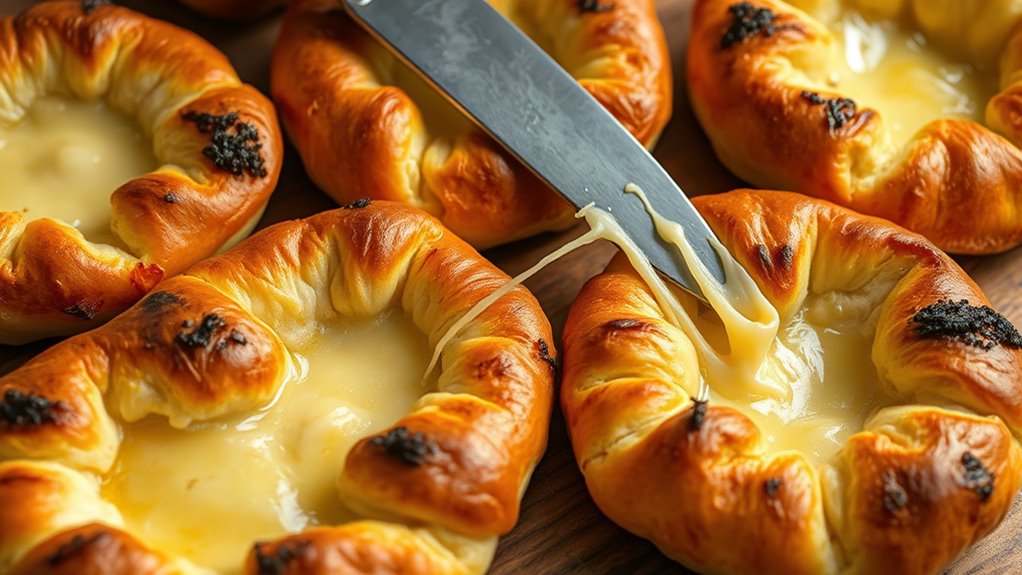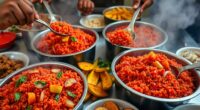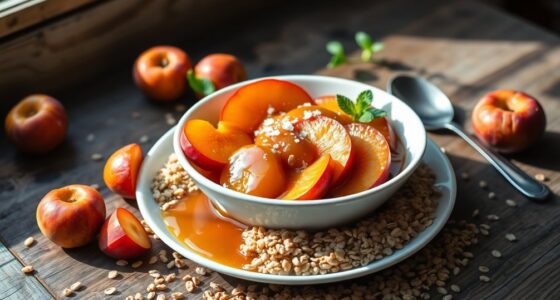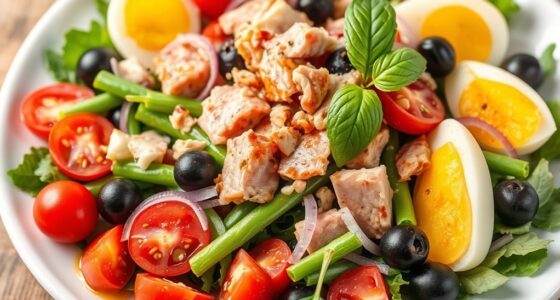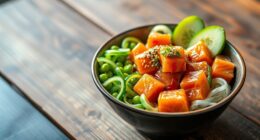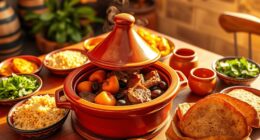Georgia’s Khachapuri cheese breads are a delicious, historic part of its culture, symbolizing hospitality and tradition. They come in various regional styles, like boat-shaped Adjarian or round Imeruli, each with unique toppings and textures. Made with simple ingredients like flour, cheese, and eggs, they’re baked until golden and bubbly. Want to discover tips for mastering these flavors or explore modern twists? Keep exploring to uncover more about this iconic Georgian dish.
Key Takeaways
- Khachapuri is a traditional Georgian cheese bread with regional variations and unique shapes.
- It typically features a dough filled or topped with cheese like sulguni or blends such as feta and mozzarella.
- Common styles include boat-shaped Adjarian, round Imeruli, and Megruli with extra cheese for crispiness.
- The cheese filling is combined with eggs and spices, baked until crust is golden and cheese is bubbly.
- Modern variations incorporate herbs, vegetables, and international flavors for creative twists.
The Origins and Cultural Significance of Khachapuri in Georgia
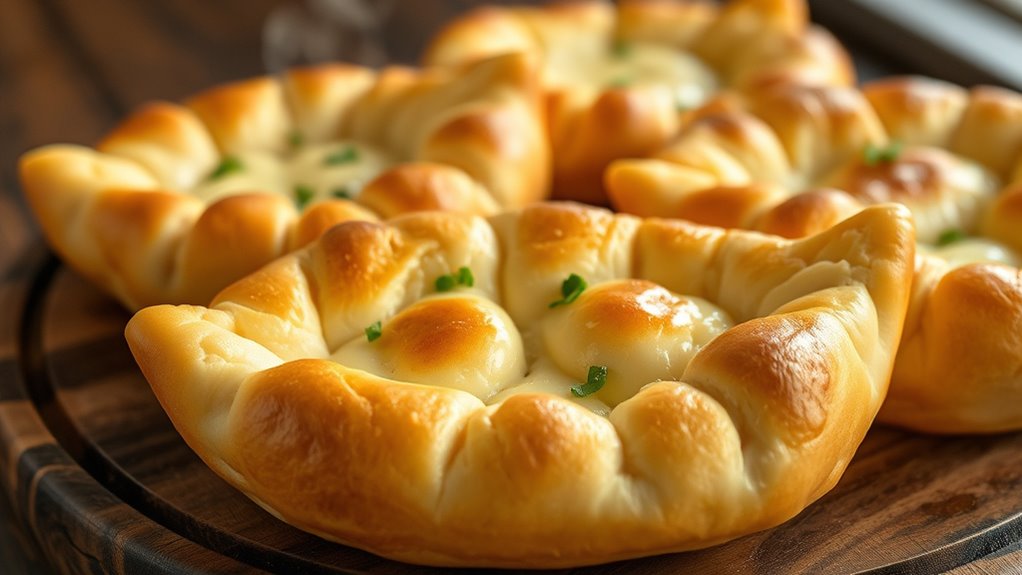
Khachapuri has been a staple of Georgian cuisine for centuries, symbolizing both everyday life and cultural identity. You might notice how it’s more than just a bread—it’s a symbol of hospitality and tradition. Historically, Khachapuri dates back to ancient Georgia, where it was prepared by rural communities using local ingredients like cheese, flour, and eggs. Over time, it became a national dish, representing Georgia’s rich culinary heritage. Families gather around Khachapuri during celebrations and daily meals, emphasizing its role in community bonding. Its significance goes beyond taste; it embodies Georgian resilience, history, and the importance placed on sharing food. Today, Khachapuri remains a proud part of Georgia’s cultural identity, connecting past and present through every bite. Traditional food practices continue to influence the way Khachapuri is prepared and enjoyed across generations.
Varieties of Khachapuri and Their Distinct Features
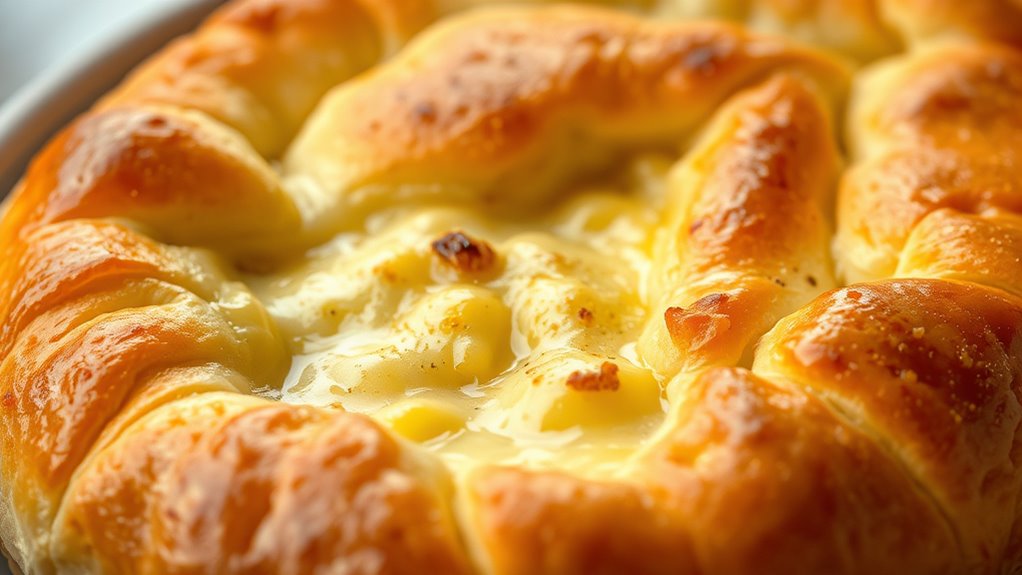
Georgia’s diverse regions have given rise to a rich variety of Khachapuri styles, each with unique features that reflect local tastes and ingredients. You’ll find differences in shape, toppings, and dough, making each version special. For example, Adjarian Khachapuri is boat-shaped with an egg yolk in the center, signaling richness. Imeruli Khachapuri is round and stuffed with cheese, offering comfort in every bite. You might also enjoy Megruli Khachapuri, topped with extra cheese for a crispy finish. Here’s a glimpse of these styles:
| Style | Shape | Key Feature |
|---|---|---|
| Adjarian | Boat-shaped | Egg yolk center, buttery crust |
| Imeruli | Round | Cheese-stuffed, soft crust |
| Megruli | Round, topped | Extra cheese, crispy edges |
Each variety captures Georgia’s vibrant culinary spirit, highlighting the distinct regional flavors that influence their preparation. These regional differences are also reflected in the varieties of Khachapuri, which showcase Georgia’s diverse culinary traditions. Additionally, understanding regional culinary influences can deepen appreciation for each style’s unique characteristics. Recognizing the cultural significance of Khachapuri can further enhance your appreciation for these traditional breads. Exploring these breads through a lens of Indigenous wellness essentials can reveal how traditional cooking practices support cultural identity and community bonding.
Classic Ingredients and Traditional Preparation Methods
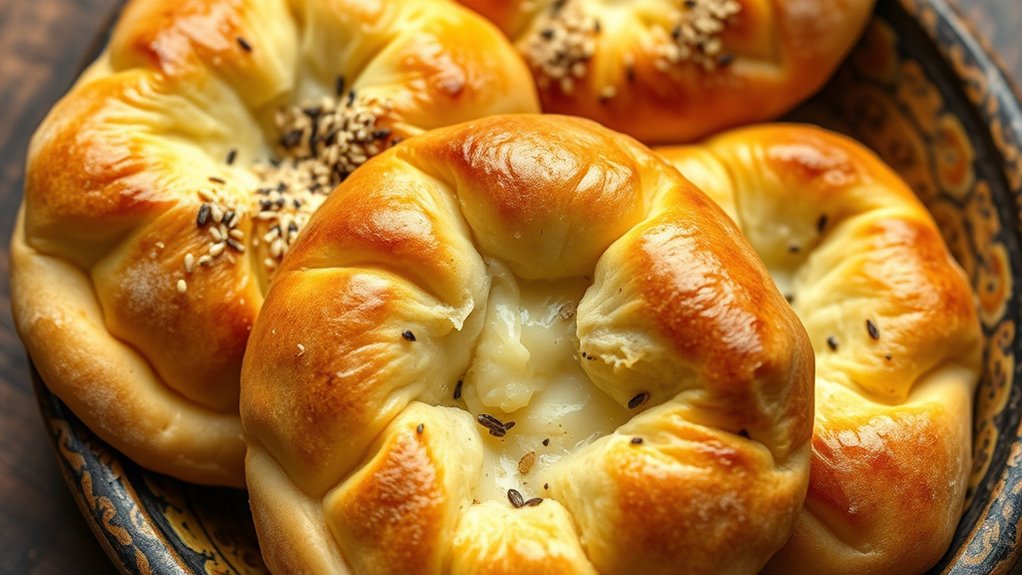
To achieve authentic flavor and texture, traditional Khachapuri relies on simple, high-quality ingredients and time-honored techniques. You start with a basic dough made from flour, water, salt, and a bit of yeast, kneaded until smooth and elastic. Let it rise slowly to develop flavor and a light, airy structure. High-quality ingredients are essential for an authentic taste. The filling features fresh, high-fat cheese like sulguni or a blend of Georgian cheeses, combined with eggs for richness and stretch. The dough is shaped into a boat or round form, then filled generously with cheese mixture. Traditionally, you bake Khachapuri in a hot oven until the crust is golden and crispy, and the cheese is bubbling. Proper dough fermentation is key to achieving the characteristic texture and flavor of the bread. The cultural heritage associated with Khachapuri highlights its significance in Georgian culinary traditions. This straightforward approach preserves the authentic taste and characteristic texture of classic Georgian Khachapuri, with fermentation time playing a crucial role in developing the dough’s flavor complexity. Additionally, understanding the role of yeast in the fermentation process can help optimize the dough’s rise and flavor development.
Tips for Perfecting Khachapuri at Home
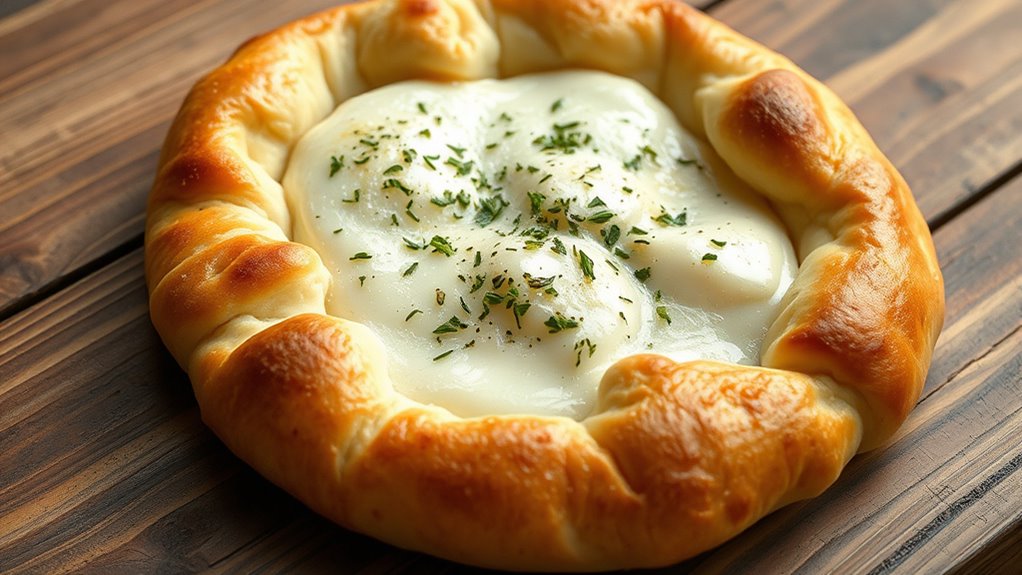
Achieving perfect Khachapuri at home requires attention to a few key details that make all the difference. First, use high-quality cheese, ideally a mix of mozzarella and feta, for authentic flavor and the right stretchiness. When preparing the dough, don’t overmix; knead just until smooth to keep it tender. Let the dough rest adequately—at least an hour—to develop gluten and enhance texture. Proper dough resting is crucial for optimal texture and flavor development. When shaping the bread, aim for an even, slightly thick rim to hold the cheese filling securely. Baking in a preheated oven at high temperature, around 475°F (250°C), until the crust is golden and bubbly, helps achieve the perfect crust. Using a proper oven temperature ensures the Khachapuri bakes evenly and develops that desirable crispy exterior. Finally, serve Khachapuri immediately for the best blend of crispy crust and gooey cheese. These tips help you achieve a delicious, authentic result every time.
Exploring Modern Twists and Creative Variations
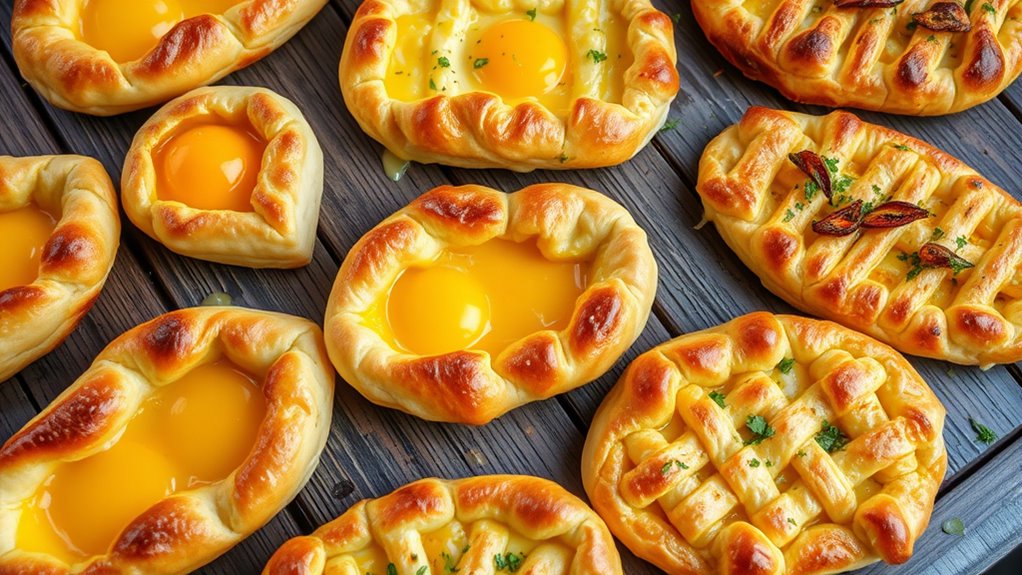
While mastering the fundamentals of making traditional Khachapuri sets a strong foundation, experimenting with modern twists can elevate your culinary experience. You can reinvent this classic by incorporating diverse ingredients and presentation styles. For example, try using different cheeses like feta or mozzarella, or add toppings such as herbs, vegetables, and meats for unique flavor combinations. Creative variations also include shaping the dough into different forms—like boats, rolls, or stuffed pockets—to suit your preference or occasion. Don’t hesitate to blend international influences, like adding spicy jalapeños or pesto. Remember, the key is to stay playful and adapt recipes to your taste. Incorporating culinary experimentation and innovative techniques can further inspire your creations. Additionally, understanding the technology behind kitchen tools and ingredients can help you achieve more precise results. Knowing how to select credible Gold IRA dealers and custodians can also enhance your investment decisions. Exploring the subconscious power during sleep can inspire new ideas for your culinary creations and boost your creativity. Here are some ideas to spark your creativity:
- Using alternative cheeses
- Incorporating fresh herbs and vegetables
- Shaping in novel forms
- Adding international flavors
Frequently Asked Questions
How Long Does Homemade Khachapuri Typically Last Before Spoiling?
You might wonder how long homemade khachapuri stays fresh. Typically, you should enjoy it within 1 to 2 days when stored in an airtight container in the fridge. After that, the cheese and bread can start to spoil or develop bacteria, making it unsafe to eat. For best taste and safety, consume it promptly and reheat it gently before serving. Avoid keeping it longer than a couple of days.
What Are Common Gluten-Free Substitutes for Traditional Khachapuri Dough?
You’re wondering about gluten-free substitutes for traditional khachapuri dough. You can use almond flour, coconut flour, or gluten-free all-purpose flour for a tasty alternative. Cauliflower crust or a blend of rice and tapioca flours also work well. Just keep in mind that these options might alter the texture and flavor slightly, so you might need to experiment to find the best match for your taste and dietary needs.
Can Khachapuri Be Made Vegan Without Losing Authenticity?
You can make khachapuri vegan without losing its essence by swapping dairy cheese for plant-based alternatives like cashew or tofu-based cheeses. Use vegan-friendly dough made with vegetable oils or plant milk instead of traditional dairy. While the flavor profile changes slightly, you’ll still enjoy that comforting, cheesy centerpiece. Experiment with spices or nutritional yeast to mimic the savory depth. With these tweaks, you preserve the dish’s authenticity while maintaining a vegan approach.
Are There Specific Cheeses Best Suited for Authentic Georgian Khachapuri?
When choosing cheeses for authentic Georgian khachapuri, you want cheeses that melt well and have a rich flavor. Traditional options include Sulguni, a fresh, slightly tangy cheese, and Imeruli, which is similar. If you can’t find these, mozzarella or feta can work as substitutes. You should look for cheeses with good meltability and a mild, creamy taste to keep the dish authentic and delicious.
How Do Regional Climate Differences Affect Khachapuri Ingredients and Preparation?
You might notice that regional climate differences influence khachapuri ingredients and preparation. In cooler areas, you’ll find richer, creamier cheeses like sulguni or ricotta, which melt well and create a gooey texture. Warmer regions often use fresher, lighter cheeses. Climate also affects flour and water quality, impacting dough consistency. Adapt your techniques accordingly, using local ingredients to achieve authentic flavors and textures in your khachapuri.
Conclusion
As you bring your khachapuri to life, remember it’s more than just cheese and bread—it’s a slice of Georgian history, woven with tradition and creativity. Picture a warm, golden boat sailing across a vibrant landscape, each bite echoing centuries of culture. With every homemade variation, you craft not just a dish but a story that bridges past and present. Embrace the journey, and let your khachapuri be a delicious voyage of discovery.
